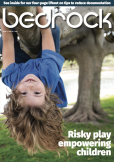Educators and teachers are encouraged to explore a range of styles and methods to document children's learning. Services can choose what documentation suits the unique context of their service, including the needs of their children, families, educators and teachers.
Did you know?
To ensure documentation is meaningful and authentic for childrenʼs learning to be made visible, educators, teachers and service leaders use their professional judgment in selecting methods that best reflect the intent and purpose of the documentation.
Complying with the national law and regulations – what services must do
The regulations define what must be done to comply with Section 168 of the Education and Care Services National Law, but they do not prescribe how to do it or what educational documentation must look like. In collaboration with services and educational leaders, approved providers will make informed decisions on the best approach to maintain documentation compliance.
Services must meet the following:
- Regulation 73
- Regulation 74(2)
- Regulation 75(a)
- Regulation 76.
The National Quality Standards (NQS) is a schedule of the National Regulations and documentation expectations are outlined in Quality Area 1 Educational Program and Practice, in particular Standard 1.3.1 Assessment and Planning:
- 1.3.1 Assessment planning cycle
- 1.3.2 Critical reflection
- 1.3.3 Information for families
Evidencing documentation under the NQS – what services may do
As the NQS is underpinned by the legislation, there will be alignment between practice that is compliant with the law and regulations, and evidence of how they meet the aligning NQS standard/s.
Careful consideration and reflection should inform decisions to promote practices that support quality outcomes for children, families, educators, and teachers and:
- align with the legislative and quality requirements
- reflect contemporary research and knowledge about childrenʼs learning and development
- eliminate or minimise duplicative or unnecessarily onerous practices
- empower educators, teachers and service leaders to build ownership of and commitment to agreed processes for documentation
- focus on the primary purpose of documentation; to inform teaching practice and childrenʼs progress
- ensure expectations/benchmarks of documentation practices are meaningful, sustainable, reasonable and achievable
- ensure documentation practices complement (rather than hinder) educatorsʼ and teachersʼ engagement in valuable learning experiences and interactions with children
- ensure that educators, teachers and service leaders have the appropriate resources (including time and professional development) to successfully undertake the documentation, and
- recognise and value the diversity of ways to document childrenʼs learning and capture each phase of the planning cycle outlined in the Early Years Learning Framework for Australia.
How authorised officers gather evidence
The Guide to the National Quality Framework is a useful tool that explains how authorised officers may observe, discuss or sight evidence.
Observe:service practices and interactions
Discuss:why and how particular practices occur at the service
Sight:documentation provided as evidence to support practices at the service.
Authorised officers will:
- empower service leaders, teachers and educators in the process of collecting evidence, so it is important to think about what an authorised officer will see happening during their visit, what you can talk about, and what documentation can be made available at assessment and rating
- use effective and efficient ways to collect evidence to assess against the NQS and underpinning legislative standards, through a combination of the observe, discuss and sight methods
- use the Guide to the National Quality Framework and the Belonging, Being and Becoming: The Early Years Learning Framework for Australia V2.0, 2022 to determine ratings and compliance.
Authorised officers will not:
- expect to see copious amounts of photographs, or videos, or
- determine the documentation, templates, apps, tools or approaches to be used.
Articulating evidence about documentation
Educators, teachers and educational leaders are encouraged to consider strategies to support their teams to articulate the thinking and planning that informs documentation. For example, it may be helpful to discuss and share thoughts about:
- theories or philosophical approaches
- how professional judgment is used
- how the documentation process reflects the related requirements of the Law, Regulations and NQS
- how the Early Years Learning Framework (EYLF) is embedded and information shared about the framework
- how the documentation is used to support each childʼs meaningful participation, engagement and progress towards the learning outcomes and is informed by each childʼs knowledge, strengths, ideas, culture, abilities and interests, and
- how children and families views and ideas have informed the documentation processes.
Reflecting on documentation and its purpose
The amount of documentation
- is setting a benchmark or quota of observations per child meaningful? Is the focus on quantity rather than quality?
- are documentation processes duplicative in any areas?
- can documentation be reduced without compromising quality?
- is the process for documentation impacting on the quality and time of interactions with children?
The purpose of the documentation
- are there opportunities to streamline or reduce documentation while continuing to meet the requirements of the regulations and the NQS?
- could documentation be more concise or used for a dual purpose?
The rights and privacy of children
- are documentation processes ensuring the most effective use of available time?
- can your processes for documentation be reduced, removed or combined to be more sustainable in the long term?
- are there other strategies that could be explored to build in or use time in the work day to effectively and concisely document, that donʼt impact on childrenʼs learning, supervision or wellbeing?










































































































































